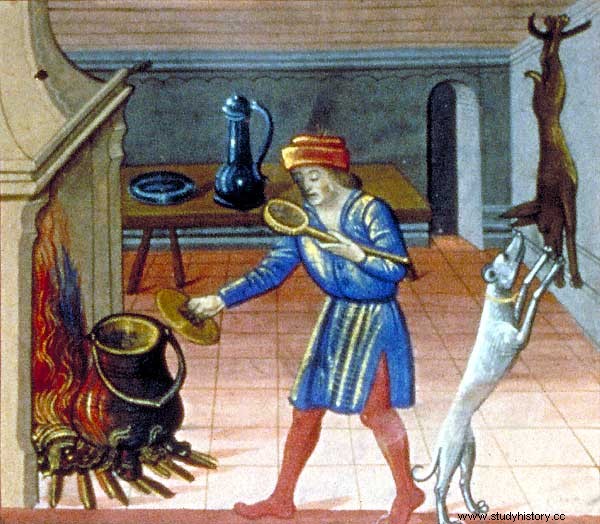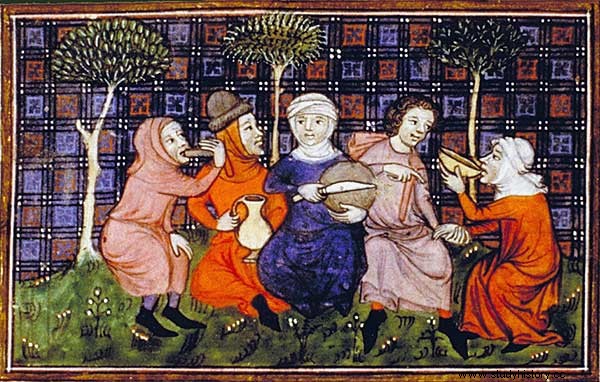Medieval people's diet was not particularly varied. It was dominated by cereal slush, sometimes spiced with a bit of meat or vegetables, and bread so hard that it literally could be broken. Hunger looked into their eyes not infrequently. Many died of exhaustion. There have even been cases of cannibalism ...
An empty stomach causes a tiresome feeling in humans. Perhaps King Frederick Barbarossa does not know what hunger is, perhaps the Archbishop of Cologne has never known hunger by ordering himself to serve the finest delicacies - but here, in the provinces, everyone has starved many times. More than once, because times are bad:the 12th century is a century of hunger .
The years of the worst disasters were recorded in the pages of chronicles:1099–1101, 1124–1126, 1145–1147, 1150/51, 1161/62 and 1195–1198. In fact, food shortages, often occurring on a smaller, regional scale, have never been recorded in the chronicles. For the way of perceiving the world, however, it is a secondary issue. A bitter personal experience is decisive:every generation of that era, almost every child, and basically every adult, experienced a famine - and with a bit of luck managed to survive it.
Silent death, loud lament
At worst, the hunger becomes audible. The cries of the hungry carry far, especially when the poor are touched by the so-called "St. Antoni ”, ergotism. It is caused by ergot, a fungus that attacks human-eaten grains of rye and wheat.
Then toxic compounds are formed, causing difficulties in breathing and circulation problems, and consequently muscle contractures, and in extreme cases necrosis of the limbs . It is a very painful ailment. The terrifying screams of the suffering echo through villages and towns, because the sick feel they are being burned alive. As one chronicler notes: It was an invisible fire that separated meat from bones and digested it.
The death of the starving is silent, but the lamentation of its witnesses is loud. A chronicler, describing the year 1099, reports about a desperate mother whose starving child experiences terrible torments before her eyes. When he can no longer bear his suffering, he kills it with poisonous weed. The corpse is placed in a huge pit along with the bodies of fifty other famine victims. Several monks take care of, comfort and nurture her desperate mother. The woman, however, suffered too much - she dies only a few days after the death of her child.

At worst, the hunger becomes audible. The cries of the hungry carry far, especially when the poor are touched by the so-called "St. Antoni ”, ergotism.
Some clergymen look after the dying in order to bury them after death in a proper and according to the church custom. They derive this obligation from the command to bury the dead, written in the Gospel of St. Matthew, who lists works of mercy. However, in the event of a famine, this commandment often remains merely a wishful thinking. There are simply too many dead. During such a catastrophe, the Bishop of Bamberg takes the necessary steps, which earns him the recognition of the chronicler:
Even the rich suffered from extreme hunger, the poor and beggars lay dead in the streets and fields in such numbers that it was impossible to bury them in cemeteries. But the clergyman ... sometimes alone, sometimes with the help of others, complied with the funeral order. Where the multitude of bodies did not allow for traditional burials, he had huge pits where hundreds and thousands of corpses were placed, dug at the same time, hiring people for money who were eagerly taking care of it.
Burned alive for… starvation
Hunger changes everything. Not only eating habits, but the whole life - and thus the principles of interpersonal coexistence. Anyone who has ever experienced the fear that they might run out of food knows that when they starve, they release the brakes.
The necessity determines the procedure. Cases of thefts are multiplying, and there are robberies and even homicides. It is impossible to protect your food from anyone. Are people still not jumping at each other's throats? It's hard to talk about it, but is still stealthily whispering that the worst was happening:acts of cannibalism . These are just rumors, no hard evidence is available, but that doesn't prejudge anything…

The text is an excerpt from Tillmann Bendikowski's book "Experience the year in the Middle Ages", which has just been published by the Znak Horyzont publishing house.
Each defeat of scarcity comes with its own legends. They are about want and abundance, good people and bad people, as well as morality. As in the story of Archbishop Hatto II of Mainz (who died in 970), still alive, although it is said that it took place in the 10th century.
This bishop was considered to be an extraordinary miser. When the poor demanded bread more and more boldly, he ordered them, as the application says, to be locked in a barn outside the city, the door should be bolted and the building set on fire. People groaned, consumed by the flames, begging for help. The bishop is credited with mocking words:"Hear, hear, that's how mice screech." However, no medieval history can do without a just punishment for the villain. We will find it much later in the Brothers Grimm in the following excerpt:
Soon God himself began to harass him; the mice ran on him day and night, nibbled on him, and he was unable to defend himself against it. Finding no other advice, he had a tower built near Bingen in the middle of the Rhine, which can still be seen today, thinking it would be safe, but mice swam across the river, climbed the tower and ate the bishop alive.
What was eaten in the Middle Ages?
You must deal ruthlessly with mice, as humans compete with them for their most important food:the grain from which they make slush. The main types of cereals are grown:barley and oats, spelled, millet, wheat and rye. Rye grows even in barren soils and in harsh climates.
The vast majority of people eat the same food every day. The coarse flour is boiled until a shapeless mass is obtained. This is the daily bread of the poor. Mainly oats are used to make mash, and porridge is the staple dish. Usually there are two main meals during the day:a morning breakfast, which looks more like a late morning breakfast, and a second one served in the early evening, between 4pm and 6pm.

The vast majority of people eat the same food every day. The coarse flour is boiled until a shapeless mass is obtained. This is the daily bread of the poor.
As no one is using the clock yet, the time of day is determined by the living conditions of the household:in summer, the second meal can be delayed until the field work is finished - unlike in winter with its short days. It was common sense to eat your evening meal in the sunshine in winter and not to use artificial and expensive lighting.
In addition to mash, the menu includes vegetables available at a given time of the year:despite regional differences, these are usually peas and lentils, beans and turnips, carrots, onions and cabbage are also grown throughout the country. Like fruit, especially apples, pears and plums, vegetables are not suitable for longer storage and are therefore eaten immediately. They are usually cooked and served as a standalone dish, not as an "addition" to bread.
Our daily bread
When it comes to food, an existential issue, the word "bread" always appears. This is why people use terms such as "our daily bread" or "to wander for the bread"; the tax paid to the feudal in some areas is called "bread" . Given the fundamental meaning of the word, it is not surprising that a community, living together under one roof, eats meals together, "breaking bread".
For Christians, bread is also more than just food, because communion, that is, the sharing of the bread in remembrance of the Last Supper of Jesus and his disciples, is the most important part of the mass. It is not uncommon for pilgrims to eat holy bread at their destination because they believe in its healing power.

For ordinary people, light bread remains a dream, they simply cannot afford it. Some people seem to be ready to see what price they will pay for this luxury item.
Bread is an ambiguous promise. No wonder that the biblical story of the miraculous multiplication of bread, eagerly preached by preachers, finds fertile ground, for this story speaks to people concerned about the abundance of daily bread.
However, bread is not equal to bread. It is not uncommon to literally break it. The bread is dry, it is difficult to chew. It is often baked with rye and the result depends mainly on the quality of the ground flour. Wheat flour is undoubtedly the best, white bread baked from it is a real delicacy. For a long time it was served only at aristocratic courts and rich monasteries, and the feudal lords even demanded from the peasants to spend their wheat supplies.
For ordinary people, light bread remains a dream, they simply cannot afford it. Some people seem to be ready to see what price they will pay for this luxury item. Isn't it enough just to look for good bread? In a place where it is said that there is always enough of it - a monastery? The monk Humbert de Romans (1190 / 1200–1277) recounts in his sermon a telling story about good, white bread and the power it exerts on people.
Source:
The text is an excerpt from the book by Tillmann Bendikowski "Experience a year in the Middle Ages", which has just been published by the Znak Horyzont publishing house.
